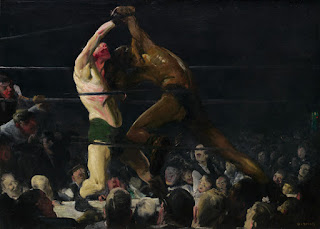Where: National Gallery of Art
When: through October 8, 2012
This is the first major retrospective of Bellows' art in three decades and the National Gallery has done a very fine job in showing examples of Bellows' work throughout his life and his many artistic periods. When I thought of George Bellows, I thought of gritty boxing matches or grimy alleys, paintings much like the one pictured here. I now know there's much more to Bellows than these works.
Bellows, who died at the age of 42 of appendicitis, has been mythologized over the years, probably because he died young, but also because he advocated no limitations on artists. He believed that art should have no constraints, and this belief enabled him to move American art from the more staid Victorian period into the wilder, more confrontational era of modern art.
The National Gallery arranges the show in chronological order (my favorite kind of order for one-artist exhibits). His early work is what is most familiar - tenements, boxing and the less attractive parts of the New York urban landscape. One of these paintings, Noon, was quite striking in its use of light - you could see the sun making its way into what would have otherwise been a dull picture. At the time that Bellows was painting boxers, bouts were held in private clubs, as New York had a statewide ban on the sport. You notice that, although the paintings are filled with people, their faces are painted in a slapdash fashion. Whether that's deliberate or because Bellows just wasn't very good at painting faces, I don't know. There's a room filled with portraits he painted, and those faces are all rather odd looking as well - they looked as if they had suffered terrible burns and their skin had become misshapen because of it.
The great surprise for me was some of Bellows' later work - he painted lovely pictures of the water in New York. Snow-capped River is just beautiful - such gorgeous colors, utterly different than his tenement scenes. He also traveled to Maine, and there are quite a few of his seascapes on display. As someone who travels to Maine every summer, it was grand to see these works and be reminded of past vacations. The influence of the impressionist and post-impressionists is clear in this work.
There are also several pieces that he painted during the First World War - propaganda paintings depicting German soldiers engaged in unspeakable brutality. I know that awful things happened during WWI, and that the civilian population of continental Europe did not escape its horrors, but I think I'm right in saying that the Germans did not actually spear babies on spikes, as depicted in one work. It would have been useful, I think, for the National Gallery to point this out.
Verdict: All in all, a wonderful show and one well worth seeing. It's quite large, so you'll have to be content to skim through on a lunch hour, or come on the weekend, when you can spend more time.

No comments:
Post a Comment